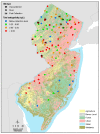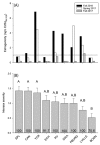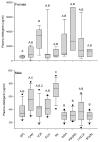Reconnaissance of Surface Water Estrogenicity and the Prevalence of Intersex in Smallmouth Bass (Micropterus Dolomieu) Inhabiting New Jersey
- PMID: 32204384
- PMCID: PMC7142597
- DOI: 10.3390/ijerph17062024
Reconnaissance of Surface Water Estrogenicity and the Prevalence of Intersex in Smallmouth Bass (Micropterus Dolomieu) Inhabiting New Jersey
Abstract
The observation of testicular oocytes in male fishes has been utilized as a biomarker of estrogenic endocrine disruption. A reconnaissance project led in the Northeastern United States (US) during the period of 2008-2010 identified a high prevalence of intersex smallmouth bass on or near US Fish & Wildlife Service National Wildlife Refuges that included the observation of 100% prevalence in smallmouth bass males collected from the Wallkill River, NJ, USA. To better assess the prevalence of intersex smallmouth bass across the state of New Jersey, a tiered reconnaissance approach was initiated during the fall of 2016. Surface water samples were collected from 101 (85 river, 16 lake/reservoir) sites across the state at base-flow conditions for estrogenicity bioassay screening. Detectable estrogenicity was observed at 90% of the sites and 64% were above the US Environmental Protection Agency trigger level of 1 ng/L. Median surface water estrogenicity was 1.8 ng/L and a maximum of 6.9 ng/L E2EqBLYES was observed. Adult smallmouth bass were collected from nine sites, pre-spawn during the spring of 2017. Intersex was identified in fish at all sites, and the composite intersex prevalence was 93.8%. Prevalence across sites ranged from 70.6% to 100%. In addition to intersex, there was detectable plasma vitellogenin in males at all sites. Total estrogenicity in surface water was determined at these fish collection sites, and notable change over time was observed. Correlation analysis indicated significant positive correlations between land use (altered land; urban + agriculture) and surface water estrogenicity. There were no clear associations between land use and organismal metrics of estrogenic endocrine disruption (intersex or vitellogenin). This work establishes a baseline prevalence of intersex in male smallmouth bass in the state of New Jersey at a limited number of locations and identifies a number of waterbodies with estrogenic activity above an effects-based threshold.
Keywords: bioassay; endocrine disruption; estrogen; fish; intersex; land use; smallmouth bass.
Conflict of interest statement
The authors declare no conflict of interest.
Figures



Similar articles
-
Evidence of estrogenic endocrine disruption in smallmouth and largemouth bass inhabiting Northeast U.S. national wildlife refuge waters: A reconnaissance study.Ecotoxicol Environ Saf. 2016 Feb;124:50-59. doi: 10.1016/j.ecoenv.2015.09.035. Epub 2015 Oct 19. Ecotoxicol Environ Saf. 2016. PMID: 26454754
-
Temporal evaluation of estrogenic endocrine disruption markers in smallmouth bass (Micropterus dolomieu) reveals seasonal variability in intersex.Sci Total Environ. 2019 Jan 1;646:245-256. doi: 10.1016/j.scitotenv.2018.07.167. Epub 2018 Jul 26. Sci Total Environ. 2019. PMID: 30055487
-
Gonadal intersex in smallmouth bass Micropterus dolomieu from northern Indiana with correlations to molecular biomarkers and anthropogenic chemicals.Environ Pollut. 2017 Nov;230:1099-1107. doi: 10.1016/j.envpol.2017.07.048. Epub 2017 Jul 31. Environ Pollut. 2017. PMID: 28783897
-
Reproductive endocrine disruption in smallmouth bass (Micropterus dolomieu) in the Potomac River basin: spatial and temporal comparisons of biological effects.Environ Monit Assess. 2012 Jul;184(7):4309-34. doi: 10.1007/s10661-011-2266-5. Epub 2011 Aug 4. Environ Monit Assess. 2012. PMID: 21814719 Free PMC article.
-
Intersex in teleost fish: are we distinguishing endocrine disruption from natural phenomena?Gen Comp Endocrinol. 2013 Oct 1;192:25-35. doi: 10.1016/j.ygcen.2013.04.005. Epub 2013 Apr 18. Gen Comp Endocrinol. 2013. PMID: 23603430 Review.
References
-
- Solecki R., Kortenkamp A., Bergman A., Chahoud I., Degen G.H., Dietrich D., Greim H., Hakansson H., Hass U., Husoy T., et al. Scientific principles for the identification of endocrine-disrupting chemicals: A consensus statement. Arch. Toxicol. 2017;91:1001–1006. doi: 10.1007/s00204-016-1866-9. - DOI - PMC - PubMed
-
- Conley J.M., Evans N., Cardon M.C., Rosenblum L., Iwanowicz L.R., Hartig P.C., Schenck K.M., Bradley P.M., Wilson V.S. Occurrence and in vitro bioactivity of estrogen, androgen, and glucocorticoid compounds in a nationwide screen of United States stream waters. Environ. Sci. Technol. 2017;51:4781–4791. doi: 10.1021/acs.est.6b06515. - DOI - PMC - PubMed
Publication types
MeSH terms
Substances
LinkOut - more resources
Full Text Sources
Research Materials
Miscellaneous

